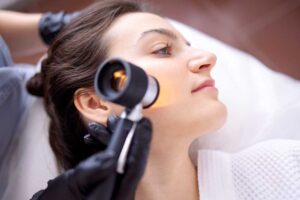Laser treatments offer low-risk ways to improve skin texture, but have a price! Laser therapies have become increasingly popular among individuals seeking to address fine lines and wrinkles, acne scarring, texture irregularities, or pigmentation changes. The side effects? Dryness, itching, redness, swelling, and a burning sensation. Also, some serious ones as well. Like skin discoloration (darkening or lightening), infection, scarring, and the reactivation of cold sores. But there are several ways to make sure you don’t suffer from these. Read on!
What to Do After Laser Hair Removal?
After laser hair removal, avoid direct sun exposure. Why? This could result in clogged pores or hyperpigmentation of the treated area. Also, don’t go near the traditional hair removal methods like waxing and plucking. The main point is, let your skin rest. Here’s how you can do so:
Moisturize After Laser Therapy
Hydrated skin heals faster. Select a gentle, fragrance-free moisturizer for treatment areas to promote rapid healing. Look for products specifically to soothe sensitive skin with ingredients like aloe vera or chamomile. This will speed up the healing process.
Avoid lotions with alcohol and exfoliating ingredients, which can irritate skin and slow its healing process. Drinking plenty of water throughout the day, drinking antioxidant-rich berries, and drinking green tea also provide skin benefits. Here are some side effects of PRP injections.
Avoid Sun Exposure
Laser hair removal makes the skin more vulnerable to UV rays. Hence, more sunburn. Therefore, you have to limit exposure before and after sessions by protecting treated areas with sunscreen or shade clothing.
Avoid sun exposure for at least 48 hours post-treatment. Whenever going out, wear protective clothing and sunscreen with SPF 30 or higher coverage. Avoid tanning beds, as these can exacerbate hyperpigmentation and lessen the results of laser hair removal treatment.
Exfoliate After Laser Resurfacing
Once your skin has fully recovered, use a non-comedogenic cleanser and gentle exfoliant two to three times weekly for gentle exfoliation of the treatment area. Be sure not to use scrubs with beads, granules, or other abrasive materials that could potentially cause microtears on sensitive skin.
Moisturize with a fragrance-free moisturizer that nourishes and keeps skin hydrated. Maintaining this regular skincare regimen is key to creating smooth and hairless skin. You might need touch-up treatments every six months or so due to hormonal shifts or other triggers. Stay connected with your aesthetician.
Avoid Hot Baths and Showers
Avoid hot baths and showers for the first several days after treatment to minimize redness and swelling in the treatment area. Excessive heat may irritate and worsen redness and swelling.
Take lukewarm showers and baths, patting dry rather than rubbing the skin dry afterward, to support its healing process and soothe any associated irritation and discomfort. For additional benefits, gentle body washes that are free from harsh chemicals and fragrances will also be helpful.
Avoid Makeup After Laser Facial Resurfacing
Applying makeup too soon after the treatment may introduce bacteria, block pores, and worsen any associated side effects. Waiting 24 hours and selecting gentle yet skin-friendly ingredients ensures your skin heals as it should. If you are considering PRP treatment, you may have some questions. One of them will be, Does PRP thicken your hair?
Possible Side Effects of CO2 Laser Skin Resurfacing
Here are some possible side effects:
Bacterial Infection
Infection will occur if you don’t take care of your skin after the treatment. Although this is a bit rare, it is still worth talking about. How does it happen? Well, laser peels basically create tiny wounds on your skin’s surface. If bacteria sneak into those spots while your skin is trying to heal, that’s when infection sets in.
The good news? You can prevent it. Keep the area clean, avoid touching your face with dirty hands, and follow your provider’s aftercare instructions religiously. Sometimes your doctor might even prescribe a topical or oral antibiotic just to be safe.
Hyperpigmentation
Hyperpigmentation occurs when the treated area heals darker than the surrounding skin. Why does this happen? The newest version of CO2 laser resurfacing (fractionated CO2) uses very short pulsed light energy. After CO2 laser beam resurfacing, your skin is already sensitive and working hard to repair itself. If it’s exposed to the sun too soon, or if your skin naturally reacts with excess melanin production, those darker patches show up.
The spots can fade over time, but they can also linger if you don’t take precautions. So, sunscreen, sunscreen, and more sunscreen. We’re talking SPF 30 or higher every single day, even when it’s cloudy. Pair that with protective clothing and shade when you can. We also recommend brightening creams or treatments to help even things out if hyperpigmentation does occur.
Scar
Laser therapy can help lessen the appearance of skin scars, but won’t necessarily erase them altogether. Hence, consider the cosmetic procedure as a journey with your doctor rather than an immediate solution. The solution is to use a bleaching agent twice daily and wear high SPF sunscreens.
A nonstick dressing on your face may also aid in healing; it may reduce scar formation and help speed up recovery time. Plus, if you are about to go for laser treatment, it’s normal to have some questions. We have prepared a guide to explain whether laser hair removal is permanent.
Swelling
This is one of the temporary side effects of healing skin. It often arises after aggressive laser treatment such as fully ablative laser resurfacing. This typically subsides over time. After this point, using a non-greasy cream, such as Aquaphor or Vaseline, helps protect it from becoming rehydrated and leading to additional irritation.
Patients with a very dark skin tone are at an increased risk for this side effect. If this is a concern, seek advice from an expert with experience in selecting and using lasers on a wide variety of skin tones. Consider other facial rejuvenation techniques that won’t change skin color, such as Intense Pulsed Light (IPL) Treatment.
Acne
Acne breakouts can pop up after CO2 laser surgery, and no, it’s not because the laser “causes” acne. What actually happens is this: some of the healing ointments or thick creams used after the procedure can clog pores, and your freshly treated skin is more sensitive than usual. The result? Whiteheads, small pimples, or small bumps appear in the treated area.
It’s annoying, but usually temporary. To manage it, stick with lightweight, non-comedogenic moisturizers and cleansers that won’t suffocate your pores. If the breakouts persist, your provider may suggest adjusting your skincare routine or prescribing a mild topical treatment to help calm the situation.
Conclusion
Laser treatments can work wonders for your skin, but they aren’t entirely free of side effects. The key takeaway? Follow your provider’s aftercare instructions to the letter, keep your skin protected from the sun, and be patient with the healing process. Most side effects are temporary and manageable, and with the right precautions, you can enjoy the fresher-looking skin that laser therapy promises.
Lasting Results with Laser Hair Removal
Unwanted hair can be stubborn, but that doesn’t mean your skin has to suffer the consequences of removing it. But laser treatment isn’t the solution. Skin Artistry Clinic targets the root cause of hair loss and offers a customized PRP hair rejuvenation treatment! At the same time, no side effects! If you’re ready to swap the endless cycle of hair removal for something that actually lasts, book your session today!



